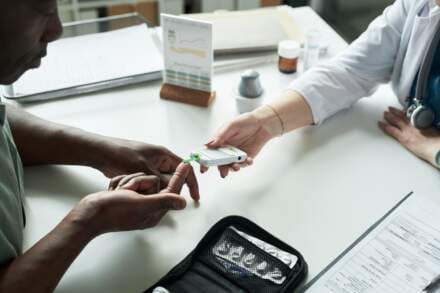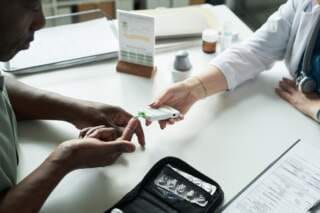Feeling a bit off lately? Maybe more tired than usual, or constantly running to the bathroom? It’s easy to dismiss subtle changes in our bodies, hoping they’ll just go away. But sometimes, these changes can be whispers – or even shouts – from our body telling us something important needs attention. One possibility could be diabetes.
It’s understandable to feel worried if you suspect something isn’t right. The word “diabetes” can sound intimidating. But knowledge is power, and understanding the potential warning signs is the first step towards taking control of your health.
My goal here isn’t to scare you, but to empower you with clear, friendly information. As someone who writes extensively about diabetes, I know how crucial early detection is. So, let’s walk through some common signs together, gently and compassionately.
What Exactly is Diabetes (in Simple Terms)?
Think of your body as needing fuel, like a car needs gasoline. That fuel comes from the food you eat, broken down into a sugar called glucose. Glucose travels in your blood, waiting to enter your cells to give them energy. To get inside the cells, glucose needs a key – a hormone called insulin, made by your pancreas.
In diabetes, there’s a problem with this system:
- Type 1 Diabetes: The body mistakenly attacks and destroys the insulin-producing cells in the pancreas. No insulin means glucose can’t get into the cells. This often develops quickly, typically in children and young adults, but can occur at any age.
- Type 2 Diabetes: The body either doesn’t make enough insulin, or the cells become resistant to the insulin that is made (like the key doesn’t fit the lock properly). Glucose struggles to get into cells. This is more common, often develops gradually over years, and is strongly linked to lifestyle factors and genetics.
- Prediabetes: Blood sugar levels are higher than normal, but not yet high enough for a Type 2 diabetes diagnosis. This is a critical warning stage where lifestyle changes can often prevent or delay full-blown diabetes.
When glucose can’t get into your cells, it builds up in your bloodstream (high blood sugar), leading to the warning signs.
Common Diabetes Warning Signs to Be Aware Of
Remember, having one or two of these symptoms doesn’t automatically mean you have diabetes. Many things can cause similar feelings. However, if you notice several of these, especially if they persist or worsen, it’s definitely time to check in with your doctor.
- Increased Thirst (Polydipsia) & Frequent Urination (Polyuria): Like Clockwork?
- What it feels like: Feeling constantly parched, no matter how much you drink. Needing to pee much more often than usual, including waking up multiple times during the night.
- Why it happens: With excess sugar in your blood, your kidneys work overtime to filter and absorb it. When they can’t keep up, the extra sugar is pulled into your urine, dragging fluids from your tissues along with it. This makes you dehydrated (thirsty) and fills your bladder more quickly (frequent urination).
- Extreme Hunger (Polyphagia): Hungry Even After Eating?
- What it feels like: Feeling intensely hungry, even shortly after a meal.
- Why it happens: Your cells aren’t getting the glucose they need for energy, even though there’s plenty of it in your blood. Your body thinks it’s starving and sends strong hunger signals, trying to get more fuel.
- Unexplained Weight Loss: Losing Weight Without Trying?
- What it feels like: Dropping pounds even though you haven’t changed your diet or exercise routine, and might even be eating more due to increased hunger.
- Why it happens: When your cells can’t get energy from glucose, your body starts breaking down muscle tissue and fat for fuel instead. This is often more noticeable in newly diagnosed Type 1 diabetes but can occur in Type 2 as well.
- Fatigue and Irritability: Feeling Drained and Grumpy?
- What it feels like: Persistent tiredness that rest doesn’t seem to fix. Feeling more irritable or moody than usual.
- Why it happens: Your cells are energy-deprived! Without sufficient glucose getting in, your body simply doesn’t have the fuel it needs to function optimally, leading to physical and mental exhaustion.
- Blurred Vision: Things Looking Fuzzy?
- What it feels like: Your eyesight seems blurry or you have trouble focusing.
- Why it happens: High blood sugar levels can pull fluid from the lenses of your eyes, affecting their ability to focus. Thankfully, this is often temporary and can improve once blood sugar levels are managed. However, long-term high blood sugar can lead to more serious eye damage.
- Slow-Healing Sores or Frequent Infections: Cuts Taking Forever to Heal?
- What it feels like: Minor cuts, scrapes, or bruises seem to linger for weeks. Getting frequent skin infections, gum infections, or urinary tract infections (UTIs), especially yeast infections in women.
- Why it happens: High blood sugar can impair your body’s natural healing processes and weaken your immune system. It can also damage blood vessels, reducing blood flow needed for healing, especially to the extremities.
- Tingling, Numbness, or Pain in Hands or Feet (Neuropathy): Pins and Needles?
- What it feels like: A sensation of pins and needles, burning, tingling, or numbness, often starting in the toes or fingers and potentially spreading upwards.
- Why it happens: Over time, high blood sugar can damage nerves throughout your body, a condition called diabetic neuropathy.
- Darkened Skin Patches (Acanthosis Nigricans): Velvety Patches?
- What it feels like: Dark, thick, often velvety patches of skin, typically appearing in body folds and creases like the neck, armpits, or groin.
- Why it happens: This is often a sign of insulin resistance, a key feature of Type 2 diabetes and prediabetes.
When to See Your Doctor: Don’t Wait!
If you’re reading this and nodding along, recognizing several of these symptoms in yourself or a loved one, please don’t ignore them or try to self-diagnose. The next step is crucial: make an appointment with your doctor.
Your doctor can listen to your concerns and order simple blood tests (like a fasting plasma glucose test, A1C test, or random plasma glucose test) to check your blood sugar levels accurately. This is the only way to know for sure if it’s diabetes, prediabetes, or something else entirely.
Taking Action is Empowering
Hearing you might have diabetes can feel overwhelming, but remember this: finding out early is the best thing you can do. Early diagnosis and management can help prevent or delay serious complications and allow you to live a long, healthy life.
Whether it’s Type 1, Type 2, or prediabetes, there are effective ways to manage the condition, including lifestyle changes (diet, exercise), medication (like metformin for Type 2), and insulin therapy (essential for Type 1, sometimes needed for Type 2). You are not alone, and support is available.
Listen to your body. If something feels off, trust your instincts and seek professional medical advice. Knowing the warning signs is the first step on the path to understanding and taking charge of your health journey.
Disclaimer: This blog post is intended for informational purposes only and does not constitute medical advice. The information provided is not a substitute for professional medical advice, diagnosis, or treatment. Always seek the advice of your physician or other qualified health provider with any questions you may have regarding a medical condition. Never disregard professional medical advice or delay in seeking it because of something you have read here.













Leave a Comment